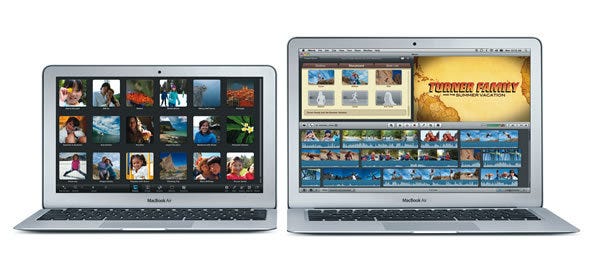Apple Introduces Smaller MacBook Air, OS X LionApple Introduces Smaller MacBook Air, OS X Lion
Steve Jobs called the new and updated Air laptops MacBook, iPad "hook-ups" at the "Back To The Mac" event, which also introduced Lion OS X and a FaceTime for the Mac beta.


MacBook Air
(click image for larger view)
MacBook Air
Apple launched on Wednesday an 11.6-inch MacBook Air, adding a smaller version of the company's thinnest and lightest notebook.
Apple Chief Executive Steve Jobs introduced the new Air, along with a refresh of the 13.6-inch version, during a news conference at the company's Cupertino, Calif., headquarters. Along with the new laptops, Apple also introduced the next version of Mac OS X, called Lion.
Apple's latest laptops are a marriage between the iPad and a notebook. In coming up with the new MacBook Airs, engineers and execs asked themselves, "What would happen if a MacBook and an iPad hooked up," Jobs said.
The two models are similar in look, in that both have aluminum unibody designs and are 0.68 of an inch at their thickest point, tapering down to 0.11 of an inch. Neither MacBook has a hard disk drive, but rather use solid-state drives, which provide instant-on capabilities, faster performance and longer battery life. Both systems have full-size keyboard and come with an Intel Core 2 Duo processor and Nvidia GeForce 320m graphics. However, the 11.6-inch model is lighter, 2.3 pounds versus 2.9 pounds, while the larger model has a higher resolution LED backlit display: 1440 x 900 pixels versus 1366 x 768 pixels. The resolutions on the new MacBook Airs are greater than on the 15-inch and 13-inch MacBook Pros, respectively. In addition, the battery life on the larger Air is longer, seven hours versus five hours, but both have a standby time of 30 hours.
Apple made both models available as of Wednesday. the 11.6-inch MacBook Air starts at $999 with a 1.4 GHz Core 2 Duo processor, 2 GB of system memory and 64 GB of flash storage. The 13.6-inch model starts at $1,299 with a 1.86 GHz Core 2 Duo, 2 GB of memory and 128 GB of flash storage.
Many industry observers expected Apple to introduce an 11.6-inch Air to compete at the high-end of thin-and-light laptops offered by Windows PC makers. In a hint of what Apple has planned for the rest of the MacBook line, Jobs said the Air represented the future in notebooks. "We see these as the next generation of MacBooks," he said.
Introducing Lion, Job said Apple had brought features from the iPhone and iPad into the new version of the Mac OS X. For example, the company introduced the Mac App Store, where people can download apps for free or a fee set by developers. Payment will be the same as for Apple's other devices. Developers get to keep 70% of the revenue and Apple keeps the rest.

MacBook Air
(click image for larger view)
MacBook Air
However, the touch screens that have driven the success of the iPhone and iPad won't be moved to Mac computers, Jobs said. The reason is user studies have shown that people don't like touch screens on their computers because their arms get tired after a period of time. "It doesn't work. It's ergonomically terrible," Jobs said. Instead, multi-touch will be confined to the trackpad on MacBooks or Apple's new trackpad for Mac desktops.
The new features demonstrated at Apple's "sneak peek" of the new OS included what the company called Mission Control, which gives a unified view of every application and Window running the Mac for easier navigation.
Lion is scheduled to be released in the summer of 2011, while the Mac App Store is set to open within 90 days. Apple plans to start accepting apps from developers next month.
Despite the popularity and attention given to the iPad and the iPhone, Apple's Mac business amounts to $22 billion, or a third of the company's revenue. The company's share of the U.S. store retail market for computers is 20.7%, according to Jobs.
Apple also announced the release of FaceTime for the Mac beta, making it possible for people to make video calls between another Mac or iPhone 4. Apple was expected to release FaceTime for the Mac, to expand the use of the software among Apple customers.
Apple also introduced iLife 11, a new version of the company's software suite that comes with the Mac. For people who want to upgrade, the software is available for $49. ILife 11 is available as of Wednesday.
Among the more interesting features added include integration between iPhoto and Facebook. Within Apple's software, people can download or post photos to Facebook and see comments made about the photos on the social network. The software also makes better use of location data added to photos in the iPhone and many digital cameras. IPhoto includes maps with virtual pushpins on locations where pictures were taken.
Apple also added a variety of new features for audio and video editing in iMovies. In general, Apple is focused on tools that automate as much of the movie-creation process as possible. One new feature Apple hopes will be popular is the ability to create trailers for home movies.
SEE ALSO:
Apple's Mac App Store Reinvents Software Sales
Apple's 'Back To The Mac' Announcement Speculation Rife
About the Author
You May Also Like




